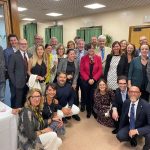
Start Cup Toscana 2023, primo posto per spinoff UNIFI e CNR
October 18, 2023
The CNR multimedia exhibition tells something about the National Institute of Optics
October 21, 2023Have you ever heard of a solid that flows like a liquid? Scientists may have just discovered a new state of matter called supersolidity.
If you are wondering what they are, supersolids are a peculiar state that combines superfluid and solid simultaneously. Sound strange, right?
A few years ago, researchers from CNR-INO, in collaboration with the University of Florence, found that certain ultracold gasses can exhibit the strange properties of both solids and liquids at the same time under certain conditions. This exciting discovery opened new possibilities for studying supersolidity and other exotic quantum states. While most of us think of solids and liquids as distinct and separate phases of matter, these scientists showed that isn’t always the case.
Under certain circumstances, solid materials can take on liquid-like properties and flow without friction. The review published by researchers from CNR-INO in Nature Physics (DOI: https://doi.org/10.1038/s42254-023-00648-2) summarizes over 15 years of research uncovering how and why this strange phenomenon occurs. Thanks to this perspective focusing on the platform of dipolar gases, in which experiments have been able to map out a number of properties of the supersolid phase, we know a gas can behave like a solid.
While we now know supersolidity is possible, many open questions remain. Scientists aim to gain a better understanding of how supersolidity forms and its properties.
Begun over 50 years ago, supersolidity is now one of the most active research frontiers in ultracold atoms, being possible on different platforms. These strange states of matter often lead to new insights and technologies we can’t even imagine yet. These supersolids may shape the future in some very unexpected ways. Science continues to surprise.
Read the review: Recati, A., Stringari, S. Supersolidity in ultracold dipolar gases. Nat Rev Phys (2023)
Read about the experiment: https://fed.ino.it/?page_





